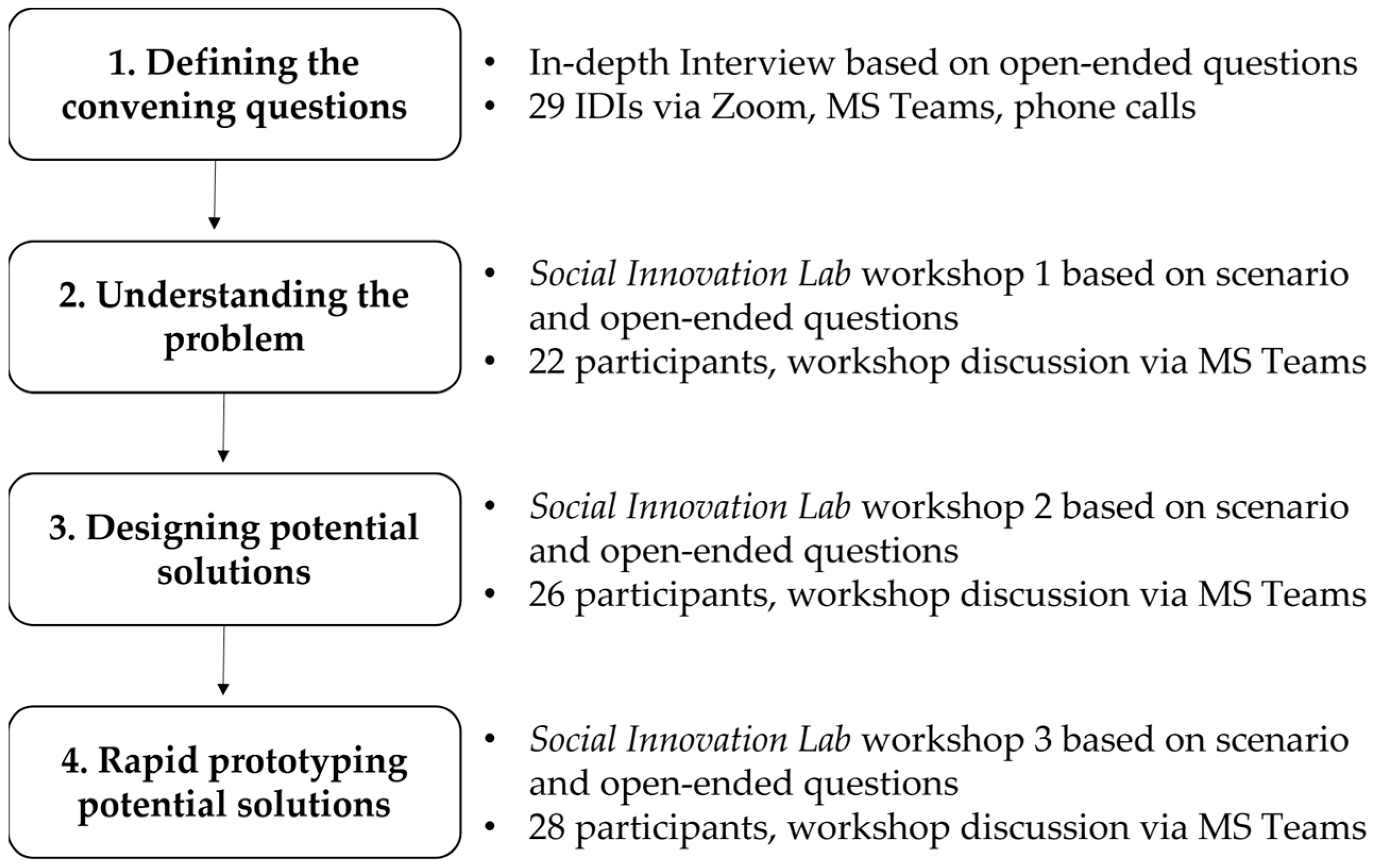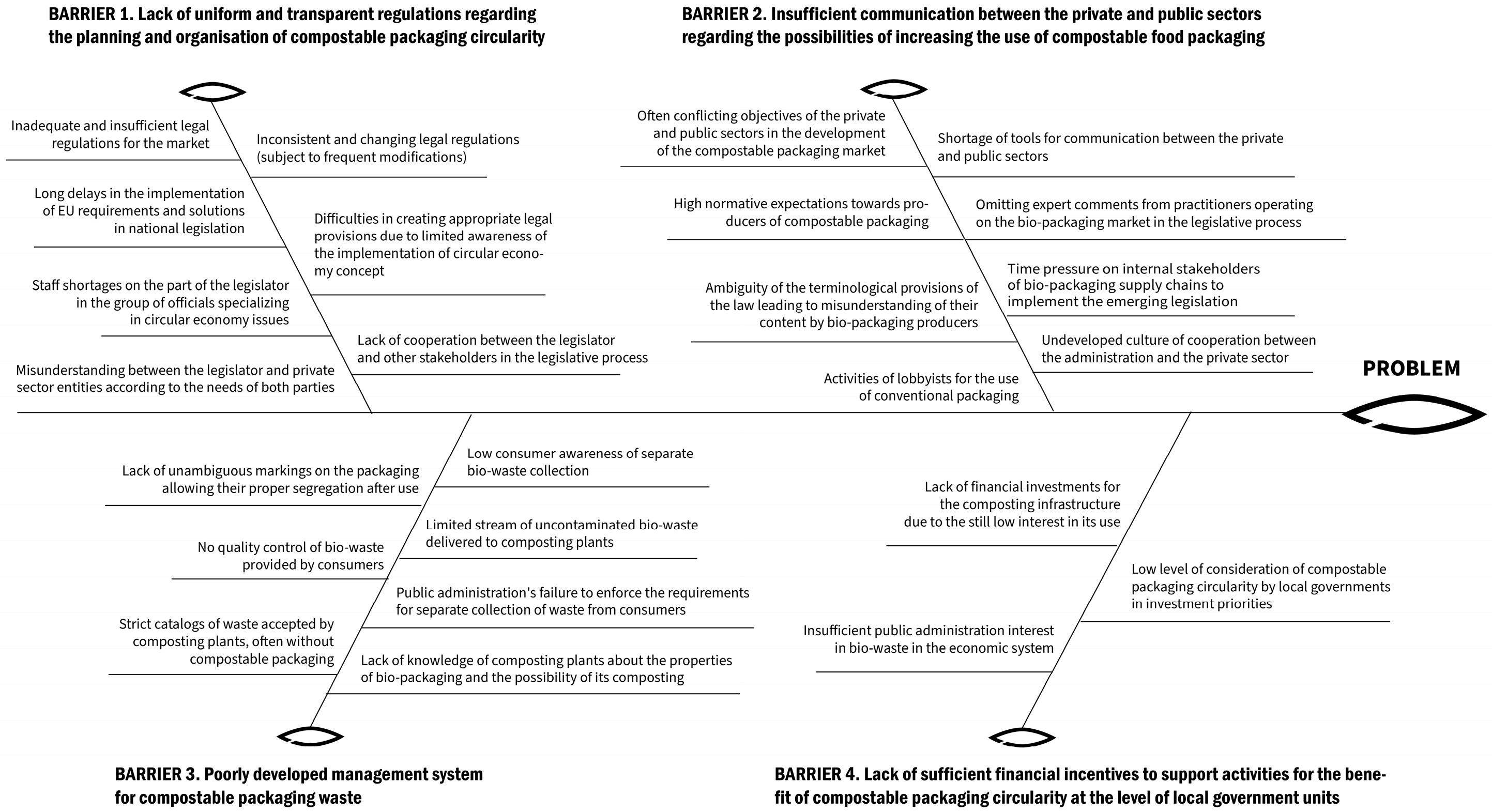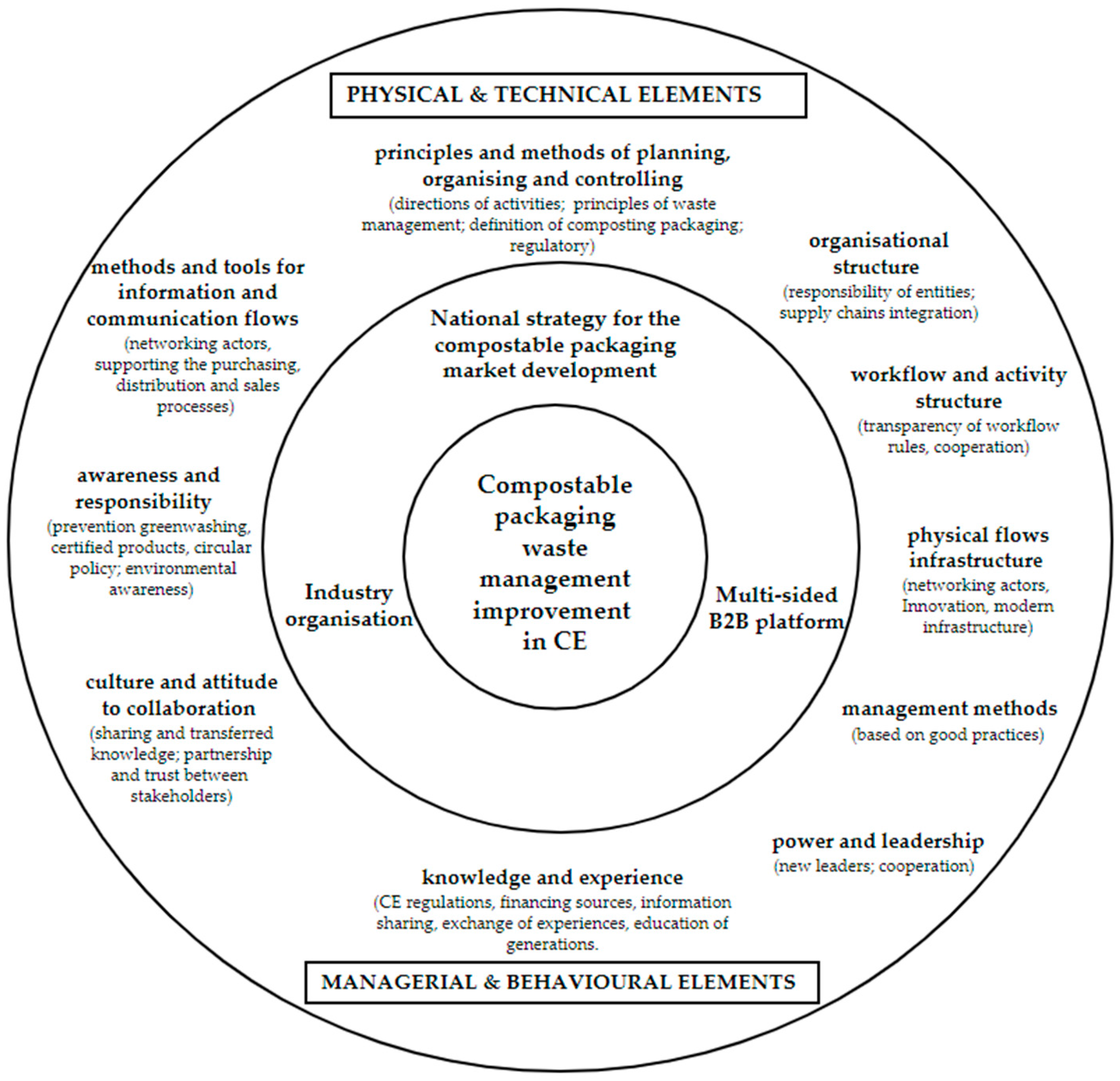Social Innovations for Improving Compostable Packaging Waste Management in CE: A Multi-Solution Perspective
Abstract
1. Introduction
2. Materials and Methods
3. Research Results
3.1. Problem under the Empirical Study
3.2. Elements Required for Waste Management
3.3. Solutions for Improving Waste Management
- Designing a strategy for the domestic compostable market development and operational documents for its implementation.
- Establishment of an association of bioplastics processors (and/or producers of compostable packaging).
- Education of all society generations based on unanimous and coherent communication.
- Creation of a law of appropriate quality.
- Increasing the awareness and qualifications of specialists who create legal regulations influencing the increase in the share of compostable packaging in the food packaging market.
- Taking into consideration the opinions of business practitioners when developing legal regulations.
- Open dialogue between the world of science, business and public administration.
- Conducting research and development projects in cooperation between scientific and business units.
- Development of optional solutions as part of bottom-up initiatives of stakeholders of compostable packaging supply chains (e.g., certification).
- Conducting a life cycle assessment of various packaging, including compostable packaging.
- National strategy for the compostable packaging market development;
- Industry organisation;
- Multi-sided B2B platform.
4. Discussion
4.1. National Strategy as a Roadmap for Compostable Packaging Waste Management
4.2. Industry Organisation as an Entity Associating Stakeholders of Compostable Packaging Waste Management
4.3. Multi-Sided B2B Platform as a Digital Tool Integrating Waste Management Entities and Processes
4.4. Comprehensive Support of Compostable Packaging Waste Management through a Multi-Solution Perspective in CE
5. Conclusions
Author Contributions
Funding
Data Availability Statement
Conflicts of Interest
Abbreviations
| B2B | Business to Business |
| CE | Circular Economy |
| EU | European Union |
| IDI | In-depth Interview |
| NGOs | Non-Governmental Organizations |
| R&D | Research and Development |
| SILs | Social Innovation Labs |
References
- European Commission. Green Paper on a European Strategy on Plastic Waste in the Environment. 2013. Available online: https://op.europa.eu/en/publication-detail/-/publication/da9aa65e-b822-4dd8-83d8-b80310315be6/language-en (accessed on 22 May 2022).
- Avio, C.G.; Gorbi, S.; Regoli, F. Plastics and microplastics in the oceans: From emerging pollutants to emerged threat. Mar. Environ. Res. 2017, 128, 2–11. [Google Scholar] [CrossRef] [PubMed]
- Salimi, A.; Alavehzadeh, A.; Ramezani, M.; Pourahmad, J. Differences in sensitivity of human lymphocytes and fish lymphocytes to polyvinyl chloride microplastic toxicity. Toxicol. Ind. Health 2022, 38, 100–111. [Google Scholar] [CrossRef]
- OECD. Global Plastics Outlook: Policy Scenarios to 2060. 2022. Available online: https://www.oecd.org/environment/plastics/ (accessed on 22 July 2022).
- MacArthur, E. Towards a Circular Economy: Business Rationale for an Accelerated Transition. Ellen MacArthur Foundation. 2015. Available online: https://ellenmacarthurfoundation.org/towards-a-circular-economy-business-rationale-for-an-accelerated-transition (accessed on 21 July 2022).
- MacArthur, E. What Is Circular Economy? Ellen MacArthur Foundation. 2022. Available online: https://ellenmacarthurfoundation.org/topics/circular-economy-introduction/overview (accessed on 21 July 2022).
- Tomić, T.; Schneider, D.R. Circular economy in waste management—Socio-economic effect of changes in waste management system structure. J. Environ. Manag. 2020, 267, 110564. [Google Scholar] [CrossRef] [PubMed]
- Nelles, M.; Grünes, J.; Morscheck, G. Waste management in Germany—Development to a sustainable circular economy? Procedia Environ. Sci. 2016, 35, 6–14. [Google Scholar] [CrossRef]
- Romero-Hernández, O.; Romero, S. Maximizing the value of waste: From waste management to the circular economy. Thunderbird Int. Bus. Rev. 2018, 60, 757–764. [Google Scholar] [CrossRef]
- Reike, D.; Vermeulen, W.J.; Witjes, S. The circular economy: New or refurbished as CE 3.0?—Exploring controversies in the conceptualization of the circular economy through a focus on history and resource value retention options. Resour. Conserv. Recycl. 2018, 135, 246–264. [Google Scholar] [CrossRef]
- Parliament and the Council of EU. Directive 2018/851 Amending Directive 2008/98/EC on Waste, 30 May 2018. 2018. Available online: https://eur-lex.europa.eu/legal-content/EN/TXT/?uri=celex%3A32018L0851 (accessed on 21 July 2022).
- MacArthur, E. Towards a Circular Economy: Opportunities for the Consumer Goods Sector. Ellen MacArthur Foundation. 2013. Available online: https://www.mckinsey.com/~/media/mckinsey/dotcom/client_service/sustainability/pdfs/towards_the_circular_economy.ashx (accessed on 18 July 2022).
- European Commission. A European Strategy for Plastics in a Circular Economy. 2018. Available online: https://eur-lex.europa.eu/resource.html?uri=cellar:2df5d1d2-fac7-11e7-b8f5-01aa75ed71a1.0001.02/DOC_1&format=PDF (accessed on 15 July 2022).
- Plastics Europe. Plastics—The Facts 2020. 2020. Available online: https://plasticseurope.org/pl/knowledge-hub/plastics-the-facts-2020/ (accessed on 22 July 2022).
- Arikan, E.B.; Ozsoy, H.D. A review: Investigation of bioplastics. J. Civ. Eng. Archit. 2015, 9, 188–192. [Google Scholar]
- Shamsuddin, I.M.; Jafar, J.A.; Shawai, A.S.A.; Yusuf, S.; Lateefah, M.; Aminu, I. Bioplastics as better alternative to petroplastics and their role in national sustainability: A review. Adv. Biosci. Bioeng. 2017, 5, 63. [Google Scholar] [CrossRef]
- Cruz, R.M.S.; Krauter, V.; Krauter, S.; Agriopoulou, S.; Weinrich, R.; Herbes, C.; Scholten, P.B.V.; Uysal-Unalan, I.; Sogut, E.; Kopacic, S.; et al. Bioplastics for Food Packaging: Environmental Impact, Trends and Regulatory Aspects. Foods 2022, 11, 3087. [Google Scholar] [CrossRef]
- European Bioplastics. What Are Bioplastics? Fact Sheet. 2018. Available online: https://docs.european-bioplastics.org/publications/fs/EuBP_FS_What_are_bioplastics.pdf (accessed on 22 July 2022).
- Mores, G.D.V.; Finocchio, C.P.S.; Barichello, R.; Pedrozo, E.A. Sustainability and innovation in the Brazilian supply chain of green plastic. J. Clean. Prod. 2018, 177, 12–18. [Google Scholar] [CrossRef]
- Ögmundarson, Ó.; Sukumara, S.; Laurent, A.; Fantke, P. Environmental hotspots of lactic acid production systems. GCB Bioenergy 2020, 12, 19–38. [Google Scholar] [CrossRef]
- Polish Chamber of Packaging. Biul. Opakowaniowy 2019, 1, 1–23. Available online: http://www.pio.org.pl/images/biuletyny/2019/Biuletyn_-_2019_-_01.pdf (accessed on 20 July 2022).
- Market Research Future. Biodegradable Plastics Market Research Report—Forecast to 2022. 2019. Available online: https://www.marketresearchfuture.com/reports/biodegradable-plastics-market-2431 (accessed on 22 July 2022).
- Seruga, P. The municipal solid waste management system with anaerobic digestion. Energies 2021, 14, 2067. [Google Scholar] [CrossRef]
- Benato, A.; D’Alpaos, C.; Macor, A. Possible Ways of Extending the Biogas Plants Lifespan after the feed-in Tariff Expiration. Energies 2022, 15, 8113. [Google Scholar] [CrossRef]
- EN 13432:2000; Packaging—Requirements for Packaging Recoverable through Composting and Biodegradation—Test Scheme and Evaluation Criteria for the Final Acceptance of Packaging. 2000. Available online: https://standards.cencenelec.eu/dyn/www/f?p=CEN:110:0::::FSP_PROJECT,FSP_ORG_ID:13285,6242&cs=14A7284248954564551DF5EBE606ABACC (accessed on 30 November 2021).
- Achinas, S.; Achinas, V.; Euverink, G.J.W. A technological overview of biogas production from biowaste. Engineering 2017, 3, 299–307. [Google Scholar] [CrossRef]
- Czekała, W.; Jasiński, T.; Grzelak, M.; Witaszek, K.; Dach, J. Biogas Plant Operation: Digestate as the Valuable Product. Energies 2022, 15, 8275. [Google Scholar] [CrossRef]
- Ciriminna, R.; Pagliaro, M. Biodegradable and compostable plastics: A critical perspective on the dawn of their global adoption. ChemistryOpen 2020, 9, 8–13. [Google Scholar] [CrossRef]
- Shrestha, A.; van Eerten-Jansen, M.C.A.A.; Acharya, B. Biodegradation of bioplastic using anaerobic digestion at retention time as per industrial biogas plant and international norms. Sustainability 2020, 12, 4231. [Google Scholar] [CrossRef]
- Directive (EU) 2019/904 of the European Parliament and of the Council of 5 June 2019 on the Reduction of the Impact of Certain Plastic Products on the Environment. 2019. Available online: https://eur-lex.europa.eu/eli/dir/2019/904/oj (accessed on 22 July 2022).
- Cynk, K. The state of the environmental awareness of students from Poland, Slovakia and Ukraine-selected results. Civ. Environ. Eng. Rep. 2017, 24, 21–37. [Google Scholar] [CrossRef]
- Cichocka, I.; Krupa, J.; Mantaj, A. The consumer awareness and behaviour towards food packaging in Poland. Econ. Sociol. 2020, 13, 304–317. [Google Scholar] [CrossRef]
- Degli-Innocenti, F. Is composting of packaging real recycling? Waste Manag. 2021, 130, 61–64. [Google Scholar] [CrossRef] [PubMed]
- Varžinskas, V.; Markevičiūtė, Z. Sustainable food packaging: Materials and waste management solutions. Environ. Res. Eng. Manag. 2020, 76, 154–164. [Google Scholar] [CrossRef]
- Paraschiv, G.I.; Hubel, S.R.; Stanciu, A.C. Optimizing the Value Chain of Recycling Biodegradable and Compostable Packaging for Sustainable Development and the Circular Economy. Ovidius Univ. Ann. Econ. Sci. Ser. 2021, 21, 444–452. [Google Scholar]
- Raźniewska, M. Compostable Packaging Waste Management—Main Barriers, Reasons, and the Potential Directions for Development. Sustainability 2022, 14, 3748. [Google Scholar] [CrossRef]
- Minichiello, V.; Aroni, R.; Timewell, E.; Alexander, L. In-Depth Interviewing: Principles, Techniques. Analysis; Pearson Education Australia: Melbourne, VIC, Australia, 2008. [Google Scholar]
- Westley, F.; Laban, S. Social Innovation Lab Guide. Available online: https://uwaterloo.ca/waterloo-institute-for-socialinnovation-and-resilience/sites/ca.waterloo-institute-for-social-innovation-and-resilience/files/uploads/files/10_silabguide_final.pdf (accessed on 21 July 2022).
- European Bioplastics. What Are Bioplastics? 2022. Available online: https://www.european-bioplastics.org/bioplastics/ (accessed on 8 August 2022).
- Australian Packaging Covenant Organisation. National Compostable Packaging Strategy. 2021. Available online: https://documents.packagingcovenant.org.au/public-documents/National%20Compostable%20Packaging%20Strategy (accessed on 10 August 2022).
- Consorzio Italiano Compostatori. What We Do. 2022. Available online: https://www.compost.it/en/what-we-do/ (accessed on 10 August 2022).
- Compost Connect. 2022. Available online: https://www.compostconnect.org/ (accessed on 10 August 2022).
- Turek, J.; Pluta-Zaremba, A.; Ocicka, B. The Risk of Technology Adoption for Packaging Circularity and Consumer Involvement: A Qualitative Approach. In Proceedings of the 39th IBIMA Conference, Granada, Spain, 30–31 May 2022; Available online: https://www.youtube.com/watch?v=Ao6rSi9sLGI (accessed on 24 July 2022).
- Ellen McArthur Foundation. 2019. Available online: https://ellenmacarthurfoundation.org/articles/the-biological-cycle-of-the-butterfly-diagram (accessed on 14 August 2022).
- Ustawa o odpadach z dnia 14 grudnia 2012 r., Dz. U. z 2022 r. poz. 699, Art. 3.1 punkt 2.; Chancellery of the Sejm, The Polish Act on Waste. Available online: https://isap.sejm.gov.pl/isap.nsf/download.xsp/WDU20130000021/U/D20130021Lj.pdf (accessed on 24 November 2022).
- Velenturf, A.P. Analysing the governance system for the promotion of industrial symbiosis in the Humber region, UK. People Place Policy Online 2016, 10, 146–173. [Google Scholar] [CrossRef]
- Lim, W.M.; Ting, D.H.; Bonaventure, V.S.; Sendiawan, A.P.; Tanusina, P.P. What happens when consumers realise about green washing? A qualitative investigation. Int. J. Glob. Environ. Issues 2013, 13, 14–24. [Google Scholar] [CrossRef]
- Fargnoli, M.; Costantino, F.; Tronci, M.; Bisillo, S. Ecological profile of industrial products over the environmental compliance. Int. J. Sustain. Eng. 2013, 6, 117–130. [Google Scholar] [CrossRef]
- Liao, C.; Li, H. Environmental education, knowledge, and high school students’ intention toward separation of solid waste on campus. Int. J. Environ. Res. Public Health 2019, 16, 1659. [Google Scholar] [CrossRef]
- Sharp, V.; Giorgi, S.; Wilson, D.C. Delivery and impact of household waste prevention intervention campaigns (at the local level). Waste Manag. Res. 2010, 28, 256–268. [Google Scholar] [CrossRef]
- Tang, Y.; Hew, K.F. Using Twitter for education: Beneficial or simply a waste of time? Comput. Educ. 2017, 106, 97–118. [Google Scholar] [CrossRef]
- Chin, W.Y.; Mees, H.L. The rising stars of social innovations: How do local governments facilitate citizen initiatives to thrive? The case of waste management in Brussels and Hong Kong. Environ. Policy Gov. 2021, 31, 533–545. [Google Scholar] [CrossRef]
- Jara-Samaniego, J.; Pérez-Murcia, M.; Bustamante, M.; Pérez-Espinosa, A.; Paredes, C.; López, M.; López-Lluch, D.; Gavilanes-Terán, I.; Moral, R. Composting as sustainable strategy for municipal solid waste management in the Chimborazo Region, Ecuador: Suitability of the obtained composts for seedling production. J. Clean. Prod. 2017, 141, 1349–1358. [Google Scholar] [CrossRef]
- Bruni, C.; Akyol, Ç.; Cipolletta, G.; Eusebi, A.L.; Caniani, D.; Masi, S.; Colón, J.; Fatone, F. Decentralized community composting: Past, present and future aspects of Italy. Sustainability 2020, 12, 3319. [Google Scholar] [CrossRef]
- Noiki, A.; Afolalu, S.A.; Abioye, A.A.; Bolu, C.A.; Emetere, M.E. Smart waste bin system: A review. In Proceedings of the IOP Conference Series: Earth and Environmental Science, 4th International Conference on Science and Sustainable Development (ICSSD 2020), “Advances in Sciences and Technology for Sustainable Development”, Ota, Nigeria, 3–5 August 2020; IOP Publishing: Bristol, UK, 2021; Volume 655, p. 012036. [Google Scholar]
- Joseph, K. Stakeholder participation for sustainable waste management. Habitat Int. 2006, 30, 863–871. [Google Scholar] [CrossRef]
- Arsova, S.; Genovese, A.; Ketikidis, P.; Alberich, J.; Solomon, A. Implementing regional circular economy policies: A proposed living constellation of stakeholders. Sustainability 2021, 13, 4916. [Google Scholar] [CrossRef]
- Palafox-Alcantar, P.G.; Hunt, D.V.L.; Rogers, C.D.F. A hybrid methodology to study stakeholder cooperation in circular economy waste management of cities. Energies 2022, 13, 1845. [Google Scholar] [CrossRef]
- Australasian Bioplastics Association. 2019. Available online: https://bioplastics.org.au/ (accessed on 28 August 2022).
- European Bioplastics. 2022. Available online: https://www.european-bioplastics.org/ (accessed on 28 August 2022).
- Zhang, J.; Fedder, B.; Wang, D.; Jennerjahn, T.C. A knowledge exchange framework to connect research, policy, and practice, developed through the example of the Chinese island of Hainan. Environ. Sci. Policy 2022, 136, 530–541. [Google Scholar] [CrossRef]
- Bietti, E.; Vatanparast, R. Data Waste. Harv. Int. Law J. Front. 2020, 61, 1–11. Available online: https://harvardilj.org/wp-content/uploads/sites/15/Bietti-and-Vatanparast-PDF-format.pdf (accessed on 10 November 2022).
- Berg, H.; Sebestyén, J.; Bendix, P.; Le Blevennec, K.; Vrancken, K. Digital Waste Management; Eionet Report—ETC/WMGE 2020/4; European Environment Agency: Norway, Iceland, 2020; Available online: https://www.eionet.europa.eu/etcs/etc-wmge/products/etc-wmge-reports/digital-waste-management (accessed on 28 August 2022).
- Abdelkafi, N.; Raasch, C.; Roth, A.; Srinivasan, R. Multi-sided platforms. Electron. Mark. 2019, 29, 553–559. [Google Scholar] [CrossRef]
- Hagiu, A.; Wright, J. Multi-sided platforms. Int. J. Ind. Organ. 2015, 43, 162–174. [Google Scholar] [CrossRef]
- Tan, B.; Lu, X.; Pan, S.L.; Huang, L. The role of IS capabilities in the development of multi-sided platforms: The digital ecosystem strategy of Alibaba.com. J. Assoc. Inf. Syst. 2015, 16, 248–280. [Google Scholar] [CrossRef]
- Eriksson, O. Energy and waste management. Energies 2017, 10, 1072. [Google Scholar] [CrossRef]
- Jeppesen, L.B.; Lakhani, K.R. Marginality and Problem-Solving Effectiveness in Broadcast Search. Organ. Sci. 2010, 21, 1016–1033. [Google Scholar] [CrossRef]
- Boudreau, K. Open Platform Strategies and Innovation: Granting Access vs. Devolving Control. Manag. Sci. 2010, 56, 1849–1872. [Google Scholar] [CrossRef]
- Trabucchi, D.; Buganza, T. Fostering digital platform innovation: From two to multi-sided platforms. Creat. Innov. Manag. 2020, 29, 345–358. [Google Scholar] [CrossRef]
- Nambisan, S.; Sawhney, M. Orchestration Processes in Network-Centric Innovation: Evidence from the Field. Acad. Manag. Perspect. 2011, 25, 40–56. [Google Scholar]



| Problem: The Low Level of Development of Compostable Packaging Waste Management | |||
|---|---|---|---|
| Barriers Determining the Problem | |||
| Barrier 1 | Barrier 2 | Barrier 3 | Barrier 4 |
| Lack of uniform and transparent regulations regarding the planning and organisation of compostable packaging circularity | Insufficient communication between the private and public sectors regarding the possibilities of increasing the use of compostable food packaging | Poorly developed management system for compostable packaging waste | Lack of sufficient financial incentives to support activities for the benefit of compostable packaging circularity at the level of local government units |
| No. | Physical and Technical Elements | Managerial and Behavioural Elements |
|---|---|---|
| 1. | Principles and methods of planning, organising and controlling | Management methods |
| 2. | Organisational structure | Power and leadership |
| 3. | Workflow and activity structure | Knowledge and experience |
| 4. | Methods and tools for information and communication flows | Awareness and responsibility |
| 5. | Physical flows infrastructure | Culture and attitude to collaboration |
| No. | Social Innovation | Example of Foreign Practice | Characteristic |
|---|---|---|---|
| 1. | National strategy for compostable packaging market development | National Compostable Packaging Strategy in Australia | It covers three main areas: packaging development supported by education and counteracting greenwashing, building a compostable packaging collection system, and activities related to the composting process development. |
| 2. | Industry organisation | Consorzio Italiano Compostatori in Italy | It is engaged in a wide range of activities to enhance biological treatment (composting and anaerobic digestion) of separated bio-waste, green waste and other organic waste feedstock to obtain organic fertilisers, biogas and biomethane and advanced biofuel. |
| 3. | Multi-sided B2B platform | Compost Connect platform in Australia | It helps to increase access to organic recycling services for compostable packaging (industrial composting) in line with the CE principles. |
Publisher’s Note: MDPI stays neutral with regard to jurisdictional claims in published maps and institutional affiliations. |
© 2022 by the authors. Licensee MDPI, Basel, Switzerland. This article is an open access article distributed under the terms and conditions of the Creative Commons Attribution (CC BY) license (https://creativecommons.org/licenses/by/4.0/).
Share and Cite
Kędzia, G.; Ocicka, B.; Pluta-Zaremba, A.; Raźniewska, M.; Turek, J.; Wieteska-Rosiak, B. Social Innovations for Improving Compostable Packaging Waste Management in CE: A Multi-Solution Perspective. Energies 2022, 15, 9119. https://doi.org/10.3390/en15239119
Kędzia G, Ocicka B, Pluta-Zaremba A, Raźniewska M, Turek J, Wieteska-Rosiak B. Social Innovations for Improving Compostable Packaging Waste Management in CE: A Multi-Solution Perspective. Energies. 2022; 15(23):9119. https://doi.org/10.3390/en15239119
Chicago/Turabian StyleKędzia, Grażyna, Barbara Ocicka, Aneta Pluta-Zaremba, Marta Raźniewska, Jolanta Turek, and Beata Wieteska-Rosiak. 2022. "Social Innovations for Improving Compostable Packaging Waste Management in CE: A Multi-Solution Perspective" Energies 15, no. 23: 9119. https://doi.org/10.3390/en15239119
APA StyleKędzia, G., Ocicka, B., Pluta-Zaremba, A., Raźniewska, M., Turek, J., & Wieteska-Rosiak, B. (2022). Social Innovations for Improving Compostable Packaging Waste Management in CE: A Multi-Solution Perspective. Energies, 15(23), 9119. https://doi.org/10.3390/en15239119






